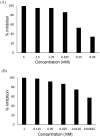Discovery of bile salt hydrolase inhibitors using an efficient high-throughput screening system
- PMID: 24454844
- PMCID: PMC3891821
- DOI: 10.1371/journal.pone.0085344
Discovery of bile salt hydrolase inhibitors using an efficient high-throughput screening system
Abstract
The global trend of restricting the use of antibiotic growth promoters (AGP) in animal production necessitates the need to develop valid alternatives to maintain productivity and sustainability of food animals. Previous studies suggest inhibition of bile salt hydrolase (BSH), an intestinal bacteria-produced enzyme that exerts negative impact on host fat digestion and utilization, is a promising approach to promote animal growth performance. To achieve the long term goal of developing novel alternatives to AGPs, in this study, a rapid and convenient high-throughput screening (HTS) system was developed and successfully used for identification of BSH inhibitors. With the aid of a high-purity BSH from a chicken Lactobacillus salivarius strain, we optimized various screening conditions (e.g. BSH concentration, reaction buffer pH, incubation temperature and length, substrate type and concentration) and establish a precipitation-based screening approach to identify BSH inhibitors using 96-well or 384-well microplates. A pilot HTS was performed using a small compound library comprised of 2,240 biologically active and structurally diverse compounds. Among the 107 hits, several promising and potent BSH inhibitors (e.g. riboflavin and phenethyl caffeate) were selected and validated by standard BSH activity assay. Interestingly, the HTS also identified a panel of antibiotics as BSH inhibitor; in particular, various tetracycline antibiotics and roxarsone, the widely used AGP, have been demonstrated to display potent inhibitory effect on BSH. Together, this study developed an efficient HTS system and identified several BSH inhibitors with potential as alternatives to AGP. In addition, the findings from this study also suggest a new mode of action of AGP for promoting animal growth.
Conflict of interest statement
Figures




Similar articles
-
Bile salt hydrolases: Structure and function, substrate preference, and inhibitor development.Protein Sci. 2018 Oct;27(10):1742-1754. doi: 10.1002/pro.3484. Epub 2018 Sep 24. Protein Sci. 2018. PMID: 30098054 Free PMC article. Review.
-
Identification and characterization of a bile salt hydrolase from Lactobacillus salivarius for development of novel alternatives to antibiotic growth promoters.Appl Environ Microbiol. 2012 Dec;78(24):8795-802. doi: 10.1128/AEM.02519-12. Epub 2012 Oct 12. Appl Environ Microbiol. 2012. PMID: 23064348 Free PMC article.
-
Antibiotic growth promoters enhance animal production by targeting intestinal bile salt hydrolase and its producers.Front Microbiol. 2014 Feb 11;5:33. doi: 10.3389/fmicb.2014.00033. eCollection 2014. Front Microbiol. 2014. PMID: 24575079 Free PMC article. Review.
-
Bacterial bile salt hydrolase: an intestinal microbiome target for enhanced animal health.Anim Health Res Rev. 2016 Dec;17(2):148-158. doi: 10.1017/S1466252316000153. Anim Health Res Rev. 2016. PMID: 28155801 Review.
-
Effect of Bile Salt Hydrolase Inhibitors on a Bile Salt Hydrolase from Lactobacillus acidophilus.Pathogens. 2014 Dec 17;3(4):947-56. doi: 10.3390/pathogens3040947. Pathogens. 2014. PMID: 25526498 Free PMC article.
Cited by
-
The complex structure of bile salt hydrolase from Lactobacillus salivarius reveals the structural basis of substrate specificity.Sci Rep. 2019 Aug 27;9(1):12438. doi: 10.1038/s41598-019-48850-6. Sci Rep. 2019. PMID: 31455813 Free PMC article.
-
Targeting the Gut Microbiota-FXR Signaling Axis for Glycemic Control: Does a Dietary Supplement Work Magic?Diabetes. 2017 Mar;66(3):571-573. doi: 10.2337/dbi16-0066. Diabetes. 2017. PMID: 28223341 Free PMC article. No abstract available.
-
Effects of riboflavin and Bacillus subtilis on internal organ development and intestinal health of Ross 708 male broilers with or without coccidial challenge.Poult Sci. 2021 Apr;100(4):100973. doi: 10.1016/j.psj.2020.12.070. Epub 2020 Dec 31. Poult Sci. 2021. PMID: 33588345 Free PMC article.
-
Bile salt hydrolases: Structure and function, substrate preference, and inhibitor development.Protein Sci. 2018 Oct;27(10):1742-1754. doi: 10.1002/pro.3484. Epub 2018 Sep 24. Protein Sci. 2018. PMID: 30098054 Free PMC article. Review.
-
Evaluation of bile salt hydrolase inhibitor efficacy for modulating host bile profile and physiology using a chicken model system.Sci Rep. 2020 Mar 18;10(1):4941. doi: 10.1038/s41598-020-61723-7. Sci Rep. 2020. PMID: 32188876 Free PMC article.
References
-
- Dibner JJ, Richards JD (2005) Antibiotic growth promoters in agriculture: history and mode of action. Poult Sci 84: 634–643. - PubMed
-
- van den Bogaard AE, Stobberingh EE (1999) Antibiotic usage in animals: impact on bacterial resistance and public health. Drugs 58: 589–607. - PubMed
-
- US FDA takes steps to reduce use of antibiotic growth promoters (2012) Vet Rec. 170: 404. - PubMed
Publication types
MeSH terms
Substances
LinkOut - more resources
Full Text Sources
Other Literature Sources
Medical

